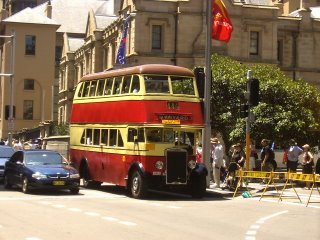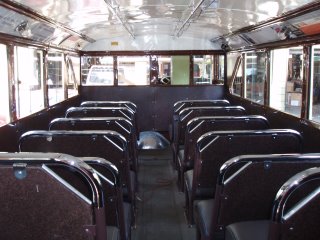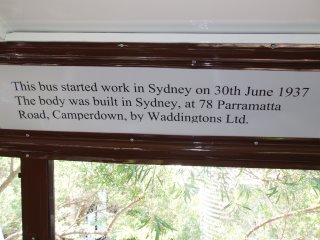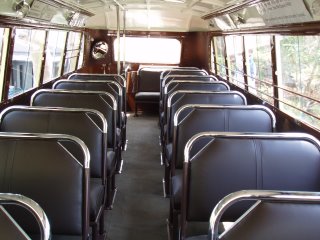
It has been said that there is a fine line between hobby and mental illness. For the bus enthusiast and in particular the amateur restorer, the line is even more uncertain. Matters such as the position of the intermediate steady bracket on the left hand staircase rail (was it above the top deck floor boards or below?) start to assume deep significance. And was it nickel plated or chromium plated?
However, I am still of sound enough mind to know that for a bus, after years of living rough, then receiving treatment, undergoing convalescence and then coming out of retirement, appearance on the streets of Sydney carrying passengers after a 48 year absence from the work force is no big deal.
But for the owner and his family, members of the Historic Commercial Vehicle Association, and many members of the public it was a great event.
Australia Day, January 26th 2007 was a brilliant sunny day: it always is. For some reason no matter what the weather leading up to the day, and on subsequent days, the day itself has been fine in living memory. This lends itself to some brilliant photographs and I attach some here. click on a photo to enlarge it
This shot was taken by Pennie Griffiths outside 333 Bobbin Head Rd. on return from inspection at Tempe Museum. The bus had just completed its very first journey of any kind since completion.

ONCE EVERYTHING WAS ASSEMBLED, AND BEFORE ANY OPERATION WITH PASSENGERS COULD BE CONTEMPLATED IT WAS NECESSARY TO OBTAIN A CERTIFICATE OF ROADWORTHINESS. As a car club, The Historic Commercial Vehicle Association is entitled to register members' vehicles under the Conditional Registration scheme, whereby anything over 30 years of age qualifies so long as a suitably approved member inspects it. One of our members is a former RTA Vehicle Inspector and well-qualified to find any weaknesses. With some trepidation I set off for the Museum at Tempe, into pouring rain. That 12 volt wiper motor from Jasper Pettie in Scotland came into its own and coped brilliantly. My fears centred largely around the brakes: TD4 and TD5 Leylands were notorious for the pedal effort necessary to achieve modest retardation, mainly due to the rather complex vacuum / hydraulic system. But on the day with some minor adjustment we achieved 60% on the Tapley Meter: marvellous!

Reversing out of the drive at 333 Bobbin, the new paint on m/0 1579 just glows. Since registration the radiator has been polished, the Leyland and Titan badges have been highlighted in black, and an odd touch from the 30s, the leather strap to hold the crank handle from swinging has been reinstated. The yellow patch at eye level will become the number plate: in the pre-war era the rear had a number plate, but the front one was painted onto the bodywork. It will say NSW m/o 1579.

THE "FLEET" TOGETHER: 1936 Leyland TD4, the former m/o 1579, and my 1946 Albion CX19, formerly m/o 1892, wait side by side outside the Sydney Town Hall.
David Wilson rather daringly stood nearly in the middle of George Street City to get this shot of my two double deckers together on the great day. Craig Parkinson is driving 1892.

STILL TOGETHER, THE ALBION AND THE LEYLAND IN ELIZABETH STREET, OPPOSITE DAVID JONES STORE, SETTING DOWN PASSENGERS AFTER A CIRCUIT OF THE CITY. photo Phil Bugby

FROM L to R, m/o 2186, a Leyland model OPD2 of 1948, m/o 1579 obscured, and Albion 1892 wait for traffic lights in George Street outside Town Hall, as they head north towards Circular Quay. photo David Wilson

TAKEN FROM THE BACK PLATFORM OF ALBION 1892, BY ITS CONDUCTOR, TRISTAN PHIPPS. The two buses have crossed Park Street and are about to stop outside the Queen Victoria Building.
The sign hanging down below the destination "WYNYARD" is the 1930s version of today's display telling the passenger "via Burwood Plaza", etc.

ITS JUST AS WELL THAT SOME PHOTOGRAPHERS TAKE PHOTOS FROM THE OTHER SIDE OF THE ROAD SOMETIMES. So many shots are of the "nearside" of a bus, but Phillip Bugby made a point of standing across the street outside David Jones to get this well-lit photo of 1579 setting down and loading passengers at the corner of of St James' Road. Some day I must arrange for a similar photo shoot in York Street city, posing the bus in exactly the same spot as the 1938 photo seen in the very first entry in this blog: "Back in 1937" posted June 2006 (see Archives).

AFTER COMPLETION. PENNIE MADE A POINT OF MOVING THROUGHOUT THE BUS RECORDING THE FINISHED ARTICLE. Downstairs looking forward, visible at floor level is the polished aluminium clutch and flywheel cover with its flowing "Leyland" script.

AT THE SUGGESTION OF GWILYM'S FIANCEE EMILY, I MADE FEW BRIEF 'ADS' DESCRIBING THE ORIGINS OF THE BUS AND ITS JOURNEY TOWARDS RESTORATION. John Dunn's book about the history of the Waddington concern, later Commonwealth Engineering, makes it clear that this bus would have been half finished when the move from Camperdown to Granville occurred. It's a moot point as to where it was actually completed.

ON THE TOP DECK, LOOKING REARWARDS. THE GENERALLY DARK FINISH ON TRIMS, AND THE PAUCITY OF INTERIOR LIGHTING ARE FEATURES OF PRE-WAR DECKERS.

DURING RESTORATION YEARS BEFORE, AS I CAME TO ENSURING THAT THREADED SOCKETS IN THE TOP DECK FLOOR GOT FITTED IN THEIR CORRECT POSITIONS, IT WAS OBVIOUS HOW LITTLE LEG ROOM PASSENGERS IN THE TOP DECK FRONT SEATS WOULD RECEIVE. AND EVERYONE COMMENTS ABOUT THE LOW CEILINGS: PRE-WAR BUSES LOST ABOUT AN INCH HERE COMPARED TO POST WAR ONES. And the driver's cab is pretty cosy, too.

ONE OF THE PERIOD ADS I MANAGED TO SAVE MANY YEARS AGO, NOT FROM THIS BUS THOUGH. This one would date from the 1960's. Are you regular, or do you worry? I do.